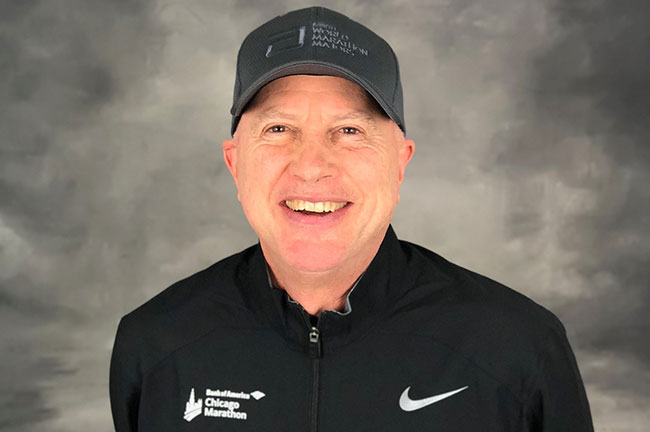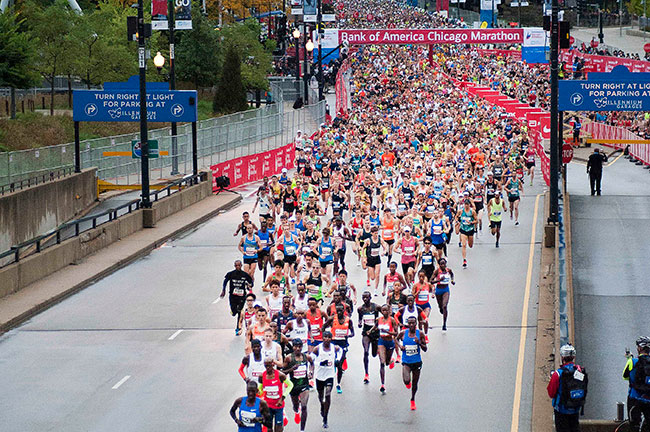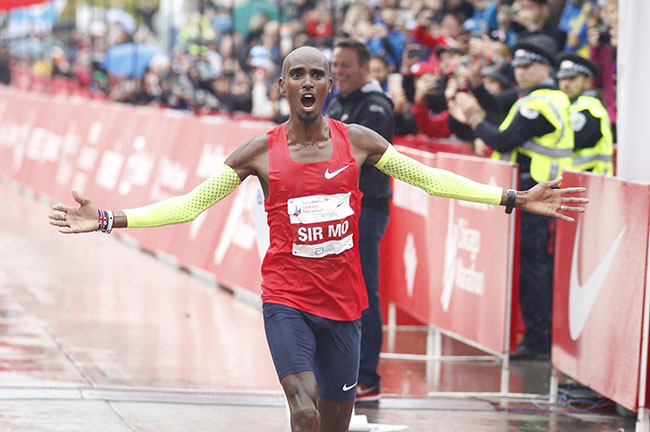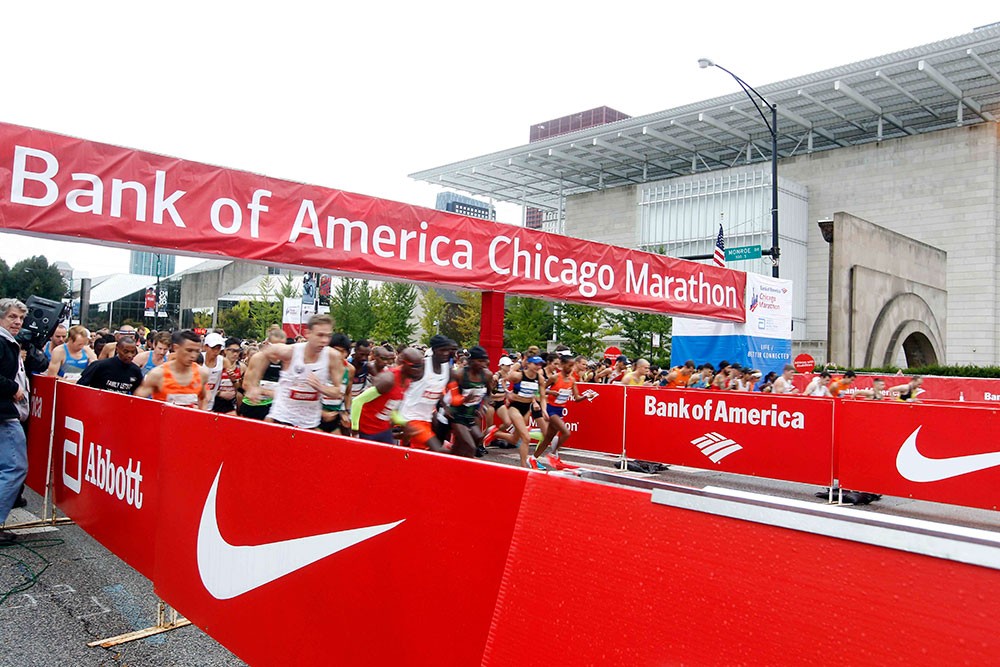This past spring, I crossed the finish line at the Boston Marathon.
It was my fifth marathon, and it took just as much planning, training and grit as every other race that came before it. Hours later, as I celebrated my accomplishment at the post-race party with other runners, I began to wonder: How long does it really take to plan for an event like this one?
I spoke with the executive race director of the Bank of America Chicago Marathon, Carey Pinkowski, and turns out, organizing a marathon takes just as much planning and work as actually racing one.

Executive Race Director Carey Pinkowski, Credit: Bank of America Chicago Marathon
The Bank of America Chicago Marathon is one of the largest marathons in the world, hosting over 40,000 participants each year. That’s a pretty huge event.
And it’s not just one day. Marathon weekend is a bunch of events within a massive one, from the pre-race expo and race day to the post-race festivities celebrating finishers.
Pinkowski, who has been the race director for Chicago Marathon for nearly 30 years, is a seasoned pro and acknowledges that events of this scale aren’t possible without a dedicated team, constant willingness to learn and collaboration with other race planners like himself.
These eight tips from Pinkowski provide a window into the amount of work that goes into planning and organizing a marathon.
1. Launch Registration Early
To kick off the planning process for the Bank of America Chicago Marathon, the first obvious step is getting runners signed up for the event. Pinkowski explained that as the years have gone by and interest in running the marathon has increased, the registration process has been moved up to almost one year ahead of the event.
“After this year’s marathon, three weeks later we will open registration for next year’s event,” Pinkowski said.
[Related Content: Off-Site Experiences Give Groups an Authentic Taste of Chicago]
Marketing registration and making the online portal easy to use is key for any event, including marathons. But welcoming 40,000-plus racers to downtown Chicago in early October takes a significant amount of travel planning and coordination for both the city and participants. The earlier runners can officially put the race on their calendars, Pinkowski explained, the better.
Key takeaway: People are busy! The more lead time you can give them to plan for your event, the more likely they are to consider participating.
2. Stay in Constant Communication with the City, the Department of Transportation, Local Venues and Other Events
After registration, Pinkowski emphasized how important it is—especially in a large city like Chicago—for the event team to stay in constant communication with the Department of Transportation and keep city-wide events happening around the same time as the marathon on their radar.
“We transform 26.2 miles of urban roadway that’s designed for high-density vehicular traffic into the Bank of America Chicago Marathon, so we have to constantly be in communication with the Department of Transportation,” Pinkowski said. “Are there construction projects? Are bridges going through rebuilds? We are constantly looking at those things.
"We also stay in communication with local venues and events that are taking place there before, during and after our event in the city. It’s really a year-round planning cycle," he added.
Key takeaway: Communication with the city is essential, especially if your event takes place outside. Schedule regular check-ins with all of the players to ensure smooth event day execution.
3. Secure City Permits and Sponsorships
After the first of the year, Pinkowski explained how important it is to secure city permits and permission to use spaces for marathon weekend.
“Every year, at the first of the year, you have to put the permits in, submit street closure requests and interact with the park district,” he said. “We use Grant Park as our start and finish meeting area, so that piece is important.”

Runners at the 2018 Chicago Marathon, Credit: Bank of America Chicago Marathon
Pinkowski added that constantly engaging with the sponsors of Bank of America Chicago Marathon is key. The marathon has secured multiyear agreements with big names like Bank of America, Nike and Gatorade, but his team often needs to plan time to offboard sponsors moving in a different direction and onboard new ones. This can be a large undertaking, so Pinkowski has a dedicated sponsorship team that focuses on managing this piece.
Key takeaway: Sponsorships and permits require a lot of attention and lead time. Get started on these pieces early and dedicate a team to managing them.
4. Engage with the Local Community
“Chicago Marathon may be the greatest tour of the city of Chicago," Pinkowski said. "We go through all 29 neighborhoods and you get to see the diversity and fiber of the community."
But he added that going through every neighborhood also means you’re disrupting many residents’ mornings on Marathon Sunday.
That makes communicating with local residents and businesses important.
[Related Content: Arts Event Venues and Group Workshops in the Chicago Suburbs]
Perhaps most impressive is that Pinkowski doesn’t only do this via email. Sometimes, he believes, the best way to engage is face-to-face.
“I’m a firm believer in connecting with the people that are affected on the course—the residents, local business, etc.—letting everyone know what’s going on and staying transparent on the route," Pinkowski said. "That sometimes is as simple as me going out on a Sunday morning, walking two or three miles on the course and connecting with people who are there.
“There might be a new house or business that has come online that wasn’t there last year," he added. "You want to make sure you connect with those people and they know what’s going on. In turn, they feel like they are a part of the event.”
Key takeaway: It’s likely your event will have some effect on the local community. Communicating with residents ahead of time and providing them with ways to get involved encourages participation and makes the whole event experience more enjoyable for all.
5. Create and Adjust Contingency Plans
As with any large event, part of the planning process is preparing for the worst.
The Bank of America Chicago Marathon hosts a lot of people—1.7 million spectators, 40,000-plus participants, 13,000 volunteers and Pinkowski’s immediate 30-person staff—which means that contingency plans are essential.
These plans span from severe weather plans to medical and active shooter scenarios.
“We recently introduced an active shooter training program for my staff, our volunteers and participants,” Pinkowski said. “That’s an element of our society now, unfortunately.
"You have to adapt with the times," he added.

Chicago Marathon Finish Line, Credit: Bank of America Chicago Marathon
In addition to active shooter training, Pinkowski also said that he worked with his medical director to implement a CPR training program.
Originally provided to the staff and coordinators, it can now be accessed by all participants, in case they see someone that needs medical attention on the course.
When I asked Pinkowski what his most challenging event day was during his 30-year career, he said it was an October snowstorm that almost derailed the marathon in 1993.
“It was brutally cold and we got six inches of snow. It was just a raw, bitter day,” Pinkowski recalled. “Chicago did a phenomenal job of getting the roadway plowed and treated and we still had the race. That was in the front end of my career and taught me you really have to think about contingencies.”
Key takeaway: Always prepare for emergency scenarios, from weather-related incidents to active shooters and medical emergencies. Training your staff and volunteers to prepare for these scenarios will make your event more secure and safe.
6. Work with Partners to Provide Room Blocks and Housing Options for Out-of-Towners
As one of the largest marathons in the world, making the travel experience to and from Chicago a positive one is key to encouraging attendees to return for a future race.
It’s a large undertaking, so Pinkowski explained that his team works with Experient to secure exclusive room blocks for participants at some of the best hotels in the city like:
- Hilton Chicago
- Hyatt Regency McCormick Place
- Chicago Downtown Marriott
- Embassy Suites Chicago
- And many more—Pinkowski says their team has relationships with 34 hotels.
In addition, the team provides participants with an online document providing helpful information like distances from each hotel to important event sites like the starting line, the expo, the finish line and O’Hare Airport.
[Related Content: 5 Chicago Rooftop Venues Take Events to New Heights]
Key takeaway: Providing attendees with housing opportunities—especially for a large event—takes a load of stress off of out-of-towners and is important to the overall event experience. Partner with experienced companies like Experient to help manage large numbers and maintain hotel relationships.
7. Collaborate and De-Brief with Other Race Directors
The Bank of Chicago Marathon is part of the Abbott World Marathon Majors, which is a series consisting of the largest and most renowned marathons in the world. These include:
- Boston Marathon
- Virgin Money London Marathon
- Tokyo Marathon
- TCS New York City Marathon
- BMW Berlin Marathon
Pinkowski explained that one of the best parts of his job is collaborating with his fellow race directors. Pinkowski attends every other Abbott World Marathon to support, observe and learn new lessons, de-briefing with the Abbott World Marathon Majors’ race directors after each event.
“It’s wonderful to attend London, for example, and see how they implement their plans. How they schedule their event, how they secure hospitality and all that,” Pinkowski said.
“We collectively get better by sharing these experiences," he added. "The events are inherently different, but there are always some similarities. There’s a real support on all levels that really makes the six of us individually and collectively better.”
Key Takeaway: Even for a seasoned planner like Pinkowski, there’s always room to learn and grow by swapping shared experiences and lessons with other planners in your field. Supporting one another and learning from other events can improve yours.
8. Review Event and Adjust for Future Events
Even for a successful, long-running event like the Bank of Chicago Marathon, Pinkowski stressed the importance of taking time to review the event with the team to make future events even more successful.
“Review and evaluate the event while it’s fresh in everyone’s minds,” Pinkowski said. “We block off two days and walk through everything that we did.
"From hospitality to registration to volunteers, we walk through things that worked, things that didn’t and what we can improve on for next year," he added.
Right after that, Pinkowski’s team opens registration for the following year, and the planning cycle starts all over again.
“Thirty years ago, marathon running used to be an extreme sport. As the years have gone on and more people have discovered running, the ultimate expression of that now is running a marathon,” Pinkowski said, reflecting on how the event has changed over the years. “There’s a broader participation base now … it has become a social phenomenon. Marathon Sunday in Chicago is something that people connect with. It has grown into an international event.”
Key takeaway: No matter how successful event day is, you can always take the time to review it and apply lessons learned to the following year’s event.
Annual events evolve over time, so don’t be afraid to evaluate and adjust.
[Read This Next: IMEX America Puts Its Best Foot Forward With Annual 5K Run]




